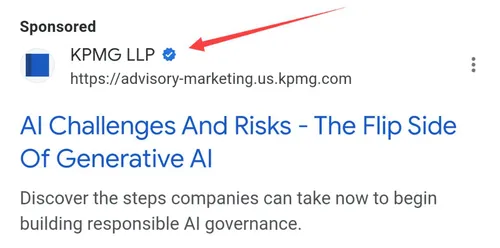Google’s New Blue Tick Help Verify Safe Search Results, Protecting Users from Fraudulent Site
TechFriday, 04 October 2024 at 16:20

Google is testing a new feature for its search engine to improve user trust when clicking on links. The idea is simple: blue ticks next to search results will mark verified companies. This new verification system aims to help users find real, safe company sites. The goal is to reduce the risk of users clicking on fake or fraudulent sites. Currently, the feature is being tested on a small group of users. This system could offer a much-needed boost in security for users, especially when shopping or looking for sensitive data. With the rise of fake websites, this step might make Google searches safer.

What Are Google Blue Ticks?
The blue ticks are small icons that will appear next to the links of certain verified companies in search results. These ticks will show that the company has passed a verification process done by Google. This system could make it easier for users to spot real companies, like Apple, Microsoft, and Amazon, from fake sites.
Google has long worked on ways to make its platform safer. Now, with the rise in cybercrime and fraudulent websites, the blue ticks are the next step. Google spokesperson, Molly Shaheen said that this is just an experiment for now, with no clear timeline for a global launch.
How Does Verification Work?
The blue tick verification is based on several checks. Some of these include:
- The authenticity of the website
- Data from Google Merchant Center
- Manual checks by Google
These checks aim to confirm that the site belongs to a real company. When you hover over the tick with your mouse, a message pops up. It tells you that the company is likely real, but Google cannot fully guarantee its safety. It’s a step towards making searches more secure, though it is not a perfect system.
BIMI and Other Related Features
This blue tick system is not Google’s first attempt at marking trusted content. Google already uses a tool called BIMI (Brand Indicators for Message Identification) in Gmail. BIMI shows verified company logos next to emails from real companies. This system has been successful in building trust in email communications, and now Google aims to bring a similar system to search results.
The blue tick feature is very much in line with what BIMI offers. Both systems aim to show users that a website or email is from a trusted company, reducing the risk of scams. If the new feature is as effective as BIMI, it could greatly improve how users interact with search results.

Limited Access During Testing
For now, only a small group of users can see the blue ticks in their search results. Google has not given any information about when, or if, this feature will be available to all users. It also does not show up consistently, even for those in the test group.
This feature could be in the testing phase for months, or it might be rolled out soon. It remains unclear how widespread the blue ticks will become or whether the feature will be changed during testing.
Impact for Users
If rolled out fully, this feature could be a game changer for online security. Users searching for sensitive information or making online purchases could benefit greatly from a visual confirmation of a site's authenticity. The blue ticks will allow users to quickly see which companies have been verified, saving them time and worry.
At the moment, users have to rely on their judgment when navigating search results. The blue ticks could make it easier to spot real companies, especially for less tech-savvy users. Trust in search results is a major concern, and this system could ease that concern.
Conclusion
Google's blue ticks represent a straightforward yet significant advancement in the battle against online fraud. By designating verified companies, this system has the potential to assist users in steering clear of fraudulent or suspicious websites. Although the feature is currently in a testing phase, it demonstrates strong potential for enhancing the security of online searches, offering a reliable method for identifying legitimate businesses. This verification initiative could ultimately contribute to safer browsing, instilling greater confidence in users when navigating the vast digital landscape.
Popular News
Latest News
Loading

